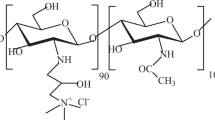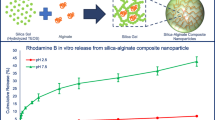Abstract
The aim of this work was to investigate the possibility of covalent cross-linker-free, polyelectrolyte complex formation at the nanoscale between alginic acid (as sodium alginate, ALG) and protamine (PROT). Optimisation of the self-assembly conditions was performed by varying the type of polymer used, pH of component solutions, mass mixing ratio of the components and the speed and order of component addition on the properties of complexes. Homogenous particles with nanometric sizes resulted when an aqueous dispersion of ALG was rapidly mixed with a solution of PROT. The polyelectrolyte complex between ALG and PROT was confirmed by infrared spectroscopy. To facilitate incorporation of drugs soluble at low pH, pH of ALG dispersion was decreased to 2; however, no nanoparticles (NPs) were formed upon complexation with PROT. Adjusting pH of PROT solution to 3 resulted in the formation of cationic or anionic NPs with a size range 70–300 nm. Colloidal stability of selected alginic acid low/PROT formulations was determined upon storage at room temperature and in liquid media at various pH. Physical stability of NPs correlated with the initial surface charge of particles and was time- and pH-dependent. Generally, better stability was observed for anionic NPs stored as native dispersions and in liquids covering a range of pH.

Schematic presenting the formation and size of alginate/protamine nanoparticles






Similar content being viewed by others
References
Andriamanantoanina H, Rinaudo M (2010) Relationship between the molecular structure of alginates and their gelation in acidic conditions. Polym Int 59:1531–1541
Augst AD, Kong HJ, Mooney DJ (2006) Alginate hydrogels as biomaterials. Macromol Biosc 6:623–633
Avadi MR, Sadeghi AMM, Dounighi NM, Dinarvand R, Atyabi F, Rafiee-Tehrani M (2011) Ex vivo evaluation of insulin nanoparticles using chitosan and arabic gum. ISRN Pharmaceutics. article ID 860109. doi:10.5402/2011/860109
Awotwe-Otoo D, Agarabi C, Keire D, Lee S, Raw A, Yu L, Habib MJ, Khan MA, Shah RB (2012) Physicochemical characterization of complex drug substances: evaluation of structural similarities and differences of protamine sulfate from various sources. AAPS J 14:619–626
Berger J, Reist M, Mayer JM, Felt O, Gurny R (2004) Structure and interactions in chitosan hydrogels formed by complexation or aggregation for biomedical applications. Eur J Pharm Biopharm 57:35–52
Bertoluzza A, Bonora S, Fini G, Morelli MA, Simoni R (1983) Phospholipid–protein molecular interactions in relation to immuno-logical processes. J Raman Spectrosc 14:395–400
Birch NP, Schiffman JD (2014) Characterization of self-assembled polyelectrolyte complex nanoparticles formed from chitosan and pectin. Langmuir 30:3441–3447
Boddohi S, Killingsworth CE, Kipper MJ (2008) Polyelectrolyte multilayer assembly as a function of pH and ionic strength using the polysaccharides chitosan and heparin. Biomacromolecules 9:2021–2028
Carneiro-da-Cunha MG, Cerqueira MA, Souza BWS, Teixeira JA, Vicente AA (2011) Influence of concentration, ionic strength and pH on zeta potential and mean hydrodynamic diameter of edible polysaccharide solutions envisaged for multinanolayered films production. Carbohydr Polym 85:522–528
Chen JH, Heitmann JA, Hubbe MA (2003) Dependency of polyelectrolyte complex stoichiometry on the order of addition. 1. Effect of salt concentration during streaming current titrations with strong poly-acid and polybase. Colloids Surf A Physicochem Eng Asp 223:215–230
Cheow WS, Hadinoto K (2012) Self-assembled amorphous drug-polyelectrolyte nanoparticle complex with enhanced dissolution rate and saturation solubility. J Colloid Interface Sci 367:518–526
Daemi H, Barikani M (2012) Synthesis and characterization of calcium alginate nanoparticles, sodium homopolymannuronate salt and its calcium nanoparticles. Scientia Iranica F 19:2023–2028
Delie F, Blanco-Prieto M (2005) Polymeric particulates to improve oral bioavailability of peptide drugs. Molecules 10:65–80
Dragan ES, Mihai M, Schwarz S (2006) Polyelectrolyte complex dispersions with a high colloidal stability controlled by the polyion structure and titrant addition rate. Colloids Surf A Physicochem Eng Asp 290:213–221
Dul M, Paluch KJ, Kelly H, Healy AM, Sasse A, Tajber L (2015) Self-assembled carrageenan/protamine polyelectrolyte nanoplexes-investigation of critical parameters governing their formation and characteristics. Carbohydr Polym 123:339–349
Elsabahy M, Wooley KL (2012) Design of polymeric nanoparticles for biomedical delivery applications. Chem Soc Rev 41(7):2545–2561
George M, Abraham TE (2006) Polyionic hydrocolloids for the intestinal delivery of protein drugs: alginate and chitosan—a review. J Control Release 114:1–14
Guarino V, Caputo T, Altobelli R, Ambrosio L (2015) Degradation properties and metabolic activities of alginate and chitosan polyelectrolytes for drug delivery and tissue engineering applications. AIMS Mater Sci 2:497–502
Holme HK, Lindmo K, Kristiansen A, Smidsrød O (2003) Thermal depolymerisation of alginate in the solid state. Carbohydr Polym 54:431–438
Holme HK, Davidsen L, Kristiansen A, Smidsrød O (2008) Kinetics and mechanisms of depolymerisation of alginate and chitosan in aqueous solution. Carbohydr Polym 73:656–664
Hu Y, Yang T, Hu X (2012) Novel polysaccharide-based nanoparticle carriers prepared by polyelectrolyte complexation for protein delivery. Polym Bull 68:1183–1199
Lankalapalli S, Kolapalli VRM (2009) Polyelectrolyte complexes: a review of their applicability in drug delivery technology. Indian J Pharm Sci 71(5):481–487
Leal D, Matsuhiro B, Rossi M, Caruso F (2008) FT-IR spectra of alginic acid block fractions in three species of brown seaweeds. Carbohydr Res 343:308–316
Lee KQ, Mooney DJ (2012) Alginate: properties and biomedical applications. Prog Polym Sci 37:106–126
Le-Tien C, Milette M, Mateescu M-A, Lacroix M (2004) Modified alginate and chitosan for lactic acid bacteria immobilization. Biotechnol Appl Biochem 39:347–354
Li P, Dai Y-N, Wei Q (2008) Chitosan-alginate nanoparticles as a novel drug delivery system for nifedipine. Int J Biomed Sci 4:221–228
Li C, Hein S, Wang K (2013) Chitosan-carrageenan polyelectrolyte complex for the delivery of protein drugs. ISRN Biomaterials. article ID 629807. doi:10.5402/2013/629807
Liechty WB, Kryscio DR, Slaughter BV, Peppas NA (2010) Polymers for drug delivery systems. Annu Rev Chem Biomol Eng 1:149–173
Mackay ME, Tuteja A, Duxbury PM, Hawker CJ, van Horn B, Guan Z, Chen G, Krishnan RS (2006) General strategies for nanoparticle dispersion. Science 311:1740–1743
Mustafaev MI (1996) Polyelectrolyes in immunology. Turk J Chem 20:126–138
Ngwuluka NC, Ochekpe NA, Aruoma OI (2014) Naturapolyceutics: the science of utilizing natural polymers for drug delivery. Polymers 6:1312–1332
Polexe RC, Delair T (2013) Elaboration of stable and antibody functionalized positively charged colloids by polyelectrolyte complexation between chitosan and hyaluronic acid. Molecules 18:8563–8578
Reynolds F, Weissleder R, Josephson L (2005) Protamine as an efficient membrane-translocating peptide. Bioconjug Chem 16:1240–1245
Saether HV, Holme HK, Maurstad G, Smidsrod O, Stokke BT (2008) Polyelectrolyte complex formation using alginate and chitosan. Carbohydr Polym 74:813–821
Sankalia MG, Mashru RC, Sankalia JM, Sutariya VB (2007) Reversed chitosan–alginate polyelectrolyte complex for stability improvement of alpha-amylase: optimisation and physicochemical characterisation. Eur J Pharm Biopharm 65:215–232
Sarmento B, Ferreira D, Veiga F, Ribeiro A (2006) Characterisation of insulin-loaded alginate nanoparticles produced by ionotropic pre-gelation through DSC and FTIR studies. Carbohydr Polym 66:1–7
Sarmento B, Bibeiro A, Veiga F, Ferreira D, Neufeld R (2007) Oral bioavailability of insulin contained in polysaccharide nanoparticles. Biomacromolecules 8:3054–3060
Silva CM, Ribeiro AJ, Ferreira D, Veiga F (2006) Insulin encapsulation in reinforced alginate microspheres prepared by internal gelation. Eur J Pharm Sci 29:148–159
Sinha VR, Kumria R (2001) Polysaccharides in colon-specific drug delivery. Int J Pharm 224:19–38
Soppimath KS, Aminabhavi TM, Kulkarni AR, Rudzinski WE (2001) Biodegradable polymeric nanoparticles as delivery devices. J Control Release 70:1–20
Srivastava A, Yadav T, Sharma S, Nayak A, Kumari A, Mishra N (2016) Polymers in drug delivery. J Biosci Med 4:69–84
Temsamani J, Vidal P (2004) The use of cell-penetrating peptides for drug delivery. Drug Discov Ther 9:1012–1019
Tønnesen HH, Karlsen J (2002) Alginate in drug delivery systems. Drug Dev Ind Pharm 28:621–630
Umerska A, Paluch KJ, Inkielewicz-Stepniak I, Santoz-Martinez MJ, Corrigan OI, Medina C, Tajber L (2012) Exploring the assembly process and properties of novel cross-linker free hyaluronate-based polyelectrolyte complex nanocarriers. Int J Pharm 436:75–87
Umerska A, Paluch KJ, Santos-Martinez MJ, Corrigan OI, Medina C, Tajber L (2014) Self-assembled hyaluronate/protamine polyelectrolyte nanoplexes: synthesis, stability, biocompatibility and potential use as peptide carriers. J Biomed Nanotechnol 10:3658–3673
Umerska A, Paluch KJ, Santos-Martinez MJ, Corrigan OI, Medina C, Tajber L (2015) Chondroitin-based nanoplexes as peptide delivery systems—investigations into the self-assembly process, solid-state and extended release characteristics. Eur J Pharm Biopharm 93:242–253
Wee S, Gombotz WR (1998) Protein release from alginate matrices. Adv Drug Del Rev 31:267–285
Wernig K, Griesbacher M, Andreae F, Hajos F, Wagner J, Mosgoeller W, Zimmer A (2008) Depot formulation of vasoactive intestinal peptide by protamine-based biodegradable nanoparticles. J Control Release 130(2):192–198
Yu X, Hou J, Shi Y, Su C, Zhao L (2016) Preparation and characterization of novel chitosan-protamine nanoparticles for nucleus-targeted anticancer drug delivery. Int J Nanomedicine 11:6035–6046
Author information
Authors and Affiliations
Corresponding author
Ethics declarations
Funding
This study was funded by Merrion Pharmaceuticals Ireland. This work was also supported by the Synthesis and Solid State Pharmaceutical Centre funded by the Science Foundation Ireland under grant number 12/RC/2275.
Conflict of interest
The authors declare that they have no conflict of interest.
Rights and permissions
About this article
Cite this article
Dul, M., Paluch, K.J., Healy, A.M. et al. Optimisation of the self-assembly process: production of stable, alginate-based polyelectrolyte nanocomplexes with protamine. J Nanopart Res 19, 221 (2017). https://doi.org/10.1007/s11051-017-3901-z
Received:
Accepted:
Published:
DOI: https://doi.org/10.1007/s11051-017-3901-z




